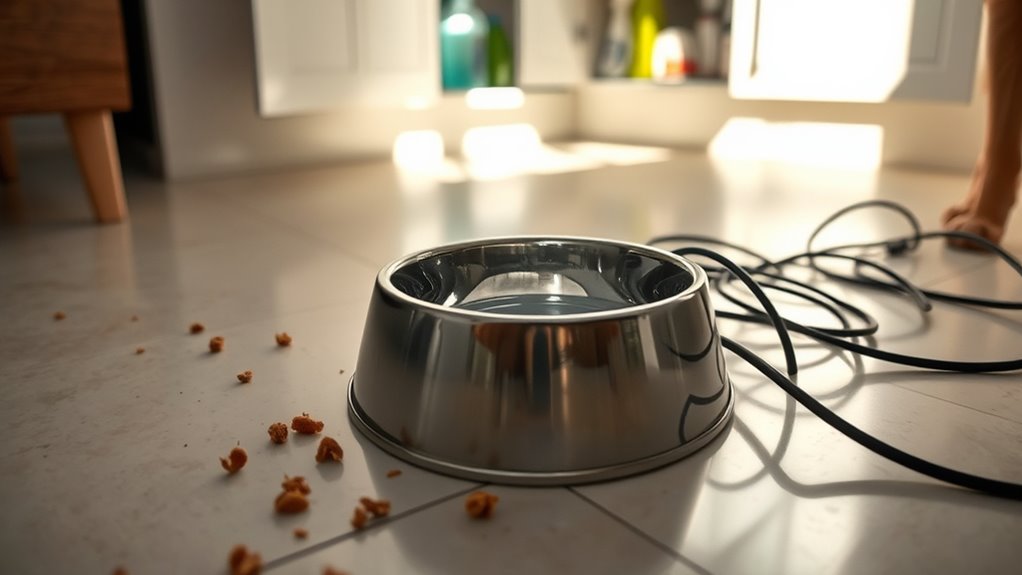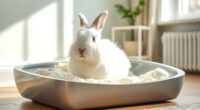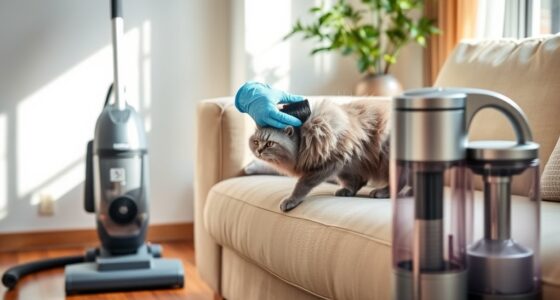Before adjusting your pet’s hydration rules, first assess their current health and environment. Check for signs of dehydration like dry gums or sunken eyes, and watch their drinking habits. Consult a veterinarian for tailored advice, identify safe water sources, and eliminate hazards in their space. Establish a routine to keep hydration consistent and explore different hydration methods. Ensuring safety and awareness lays the groundwork for better hydration, and more tips await if you continue exploring.
Key Takeaways
- Assess your pet’s current hydration status through signs like skin elasticity and gum moisture before intervening.
- Consult a veterinarian to determine specific hydration needs and appropriate solutions for your pet.
- Ensure the water source is clean, fresh, and suitable for your pet’s preferences to encourage regular drinking.
- Monitor your pet’s drinking habits and maintain a consistent hydration routine for optimal health.
- Check the environment for hazards or contaminants that could affect hydration safety before providing water.
Assess Your Pet’s Current Hydration Status

Before giving your pet additional fluids, evaluating their current hydration status is essential. Many hydration myths suggest that pets always drink enough water, but that’s not true. You need to check if your pet is properly hydrated first. Start by examining their skin elasticity—pinch their skin gently on the back of the neck; if it doesn’t quickly return to normal, they may be dehydrated. Also, look at their gums—dry or sticky gums indicate dehydration. Don’t assume water quality isn’t important; contaminated or stale water can mislead your pet into drinking less. Ensuring your pet’s hydration is right begins with honest assessment. This way, you’ll avoid overhydrating or underhydrating, both of which can be harmful. Additionally, understanding special occasions related to pet care can help you recognize signs of dehydration during stressful or busy times.
Consult With Your Veterinarian

Consulting with your veterinarian is the best way to guarantee your pet stays properly hydrated. They can assess your pet’s specific needs and recommend suitable options, whether it’s choosing the right pet water bowls or suggesting hydration supplements. Veterinarians can identify underlying health issues that may affect hydration and advise on tailored solutions. They might recommend adding hydration supplements to your pet’s water or diet if necessary, ensuring *ideal* fluid intake. Remember, not all pets have the same hydration needs, and what works for one might not work for another. Regular check-ins with your vet help you stay informed and proactive about your pet’s hydration, preventing issues before they become serious. Understanding animal health considerations can further support your pet’s well-being. Trust their expertise to keep your furry friend healthy and well-hydrated.
Understand Your Pet’s Specific Water Needs

To guarantee your pet stays properly hydrated, you need to understand their unique water requirements. Avoid falling for hydration myths that suggest all pets need the same amount of water, because individual needs vary based on age, size, and activity level. Pay attention to water temperature—pets often prefer fresh, cool water, which encourages drinking. Some pets may prefer running water from a fountain, while others might be content with still water. Remember, dehydration signs differ among species, so learn what’s normal for your pet. Providing the right water temperature and understanding their specific needs helps prevent dehydration and promotes overall health. Tailoring hydration habits to your pet’s preferences ensures they stay comfortable, healthy, and properly hydrated every day. Additionally, incorporating remote work strategies like flexible routines can help you monitor your pet’s hydration more effectively throughout the day.
Observe Your Pet’s Drinking Habits

Pay attention to how often your pet drinks and when they prefer to do so. Noticing these patterns helps you spot any changes that might signal health issues. Also, take note of their water preferences to make certain they stay properly hydrated. Utilizing wall organization systems can help you keep track of your pet’s supplies and hydration schedule more efficiently.
Monitor Drinking Frequency
Keeping a close eye on how often your pet drinks can provide valuable insight into their health. Regular hydration tracking helps you spot issues early, like dehydration or illness. To do this effectively, monitor their drinking frequency daily. Make certain water bowl maintenance is consistent so your pet always has clean water. Record how many times they drink each day to detect patterns or changes. Here’s an example:
| Time of Day | Number of Drinks |
|---|---|
| Morning | 2 |
| Afternoon | 3 |
| Evening | 2 |
| Night | 1 |
Tracking these habits helps you recognize when something’s off. If your pet suddenly drinks more or less, consult your vet. Being attentive with hydration tracking ensures your pet stays healthy and well-hydrated. Emotional support can also play a role in encouraging your pet to drink regularly.
Note Water Preferences
Observing your pet’s water preferences can reveal important insights into their health and comfort. Pay attention to whether they prefer flavor options or stick to plain water, as some pets are more responsive to flavored water or broth. Notice their favored water temperature—do they drink more when the water is cool, room temperature, or slightly warm? These preferences can indicate underlying health issues or comfort levels. For example, a sudden reluctance to drink cold water might signal dental discomfort, while a preference for warmer water could suggest illness. Keeping track of these habits helps you tailor hydration choices to your pet’s needs, encouraging consistent drinking and supporting their overall well-being. Proper hydration and adjusting water type or temperature based on their preferences can make a significant difference.
Check for Signs of Dehydration or Overhydration

Since your pet’s hydration status can change quickly, it’s important to watch for clear signs of dehydration or overhydration. Monitoring hydration cues helps you catch issues early. Look for signs to watch such as dry gums, lethargy, or sunken eyes, which indicate dehydration. Conversely, overhydration may cause swelling, vomiting, or frequent urination. Use this table to recognize key hydration cues:
| Signs to Watch | Dehydration Indicators | Overhydration Indicators |
|---|---|---|
| Eye condition | Sunken eyes | Puffy or swollen eyes |
| Gums | Dry or sticky gums | Excess saliva or swelling |
| Activity level | Lethargy or weakness | Excessive lethargy or discomfort |
Additionally, staying informed about hydration management strategies can help you maintain your pet’s health more effectively.
Review Safe Drinking Water Options

Making certain your pet has access to safe drinking water is essential for maintaining proper hydration and overall health. Reviewing your options helps you choose the best source to keep your pet healthy. Filtered water through water filtration systems can remove impurities, chemicals, and contaminants, making it safer for your pet to drink. You might also consider providing bottled water if tap water quality is questionable. Regularly cleaning your pet’s water bowl prevents bacteria buildup and ensures fresh water. Additionally, check local water reports to assess tap water safety. Using water filtration can considerably improve water quality and reduce health risks. Incorporating proper water management practices into your routine can further ensure your pet’s hydration and well-being. Always prioritize safe drinking options to support your pet’s hydration and well-being.
Identify Potential Hazards in Your Pet’s Environment

To keep your pet safe, you need to actively identify potential hazards in their environment. Pet proofing hazards can include accessible cords, small objects they might swallow, or toxic plants within reach. Environmental risks like open trash cans, chemicals, or standing water can also pose serious threats. Regularly scan your space for items that could cause injury or illness, and remove or secure them. Pay attention to areas where your pet spends time—check for sharp edges, loose wires, or anything they could accidentally ingest or get hurt by. By proactively spotting these hazards, you reduce the risk of accidents and create a safer environment that supports proper hydration and overall well-being. Staying vigilant is key to preventing preventable emergencies.
Establish a Consistent Hydration Routine

Creating a consistent hydration routine helps your pet stay healthy and happy. Set a daily schedule so they know when to expect water, and refill their bowl with fresh water regularly. This simple habit keeps hydration steady and reduces the risk of dehydration.
Set a Daily Schedule
Establishing a consistent hydration routine helps your pet stay healthy and prevents dehydration. Setting a daily schedule ensures they get water at regular intervals, making hydration automatic and less stressful. Consistency helps you monitor water intake and spot any issues early. When planning, consider water temperature; lukewarm water is often more appealing. Use hydration accessories like automatic water dispensers or bowls with filters to keep water fresh and accessible. Stick to specific times for refilling and cleaning water containers to maintain routine. Incorporating portable hydration solutions can further improve your pet’s drinking habits in various settings. A steady schedule minimizes the risk of your pet missing out on essential hydration and keeps habits predictable. By establishing this routine, you make hydration a seamless part of their daily life, promoting long-term health and well-being.
Use Fresh Water Regularly
Using clean water consistently is essential for maintaining your pet’s hydration and health. Always provide clear, unfailing water to ensure good water quality, which encourages your pet to drink regularly. Replace the water at least once a day, or more often if needed, especially in hot weather or if you have multiple pets. Avoid letting water sit stagnant, as it can become contaminated and discourage drinking. Keep water bowls clean and placed in a quiet, accessible spot. Regularly invigorating the water helps prevent bacteria buildup and ensures your pet always has access to safe hydration. Monitoring indoor air quality can also help identify if environmental factors are affecting your pet’s health or water intake. Establishing a routine of offering fresh water consistently supports your pet’s overall well-being and reduces the risk of dehydration.
Educate Yourself on Different Hydration Methods

Understanding the various hydration methods available for your pet is essential to guarantee they stay healthy and comfortable. You should explore options beyond just fresh water, such as electrolyte solutions that help replenish lost minerals during illness or heat. Hydration gadgets like automatic water fountains or portable bottles can encourage pets to drink more regularly. These tools are especially helpful if your pet is picky or if you’re away often. Learning about different approaches allows you to choose the best fit for your pet’s needs. For example, electrolyte solutions can be useful during recovery, while hydration gadgets provide convenience. Staying informed ensures you’re proactive in maintaining your pet’s hydration and overall health. AI security advancements in monitoring pet health are also emerging, making it easier to track hydration levels remotely.
Frequently Asked Questions
How Often Should I Change My Pet’s Water?
You should change your pet’s water at least once daily to guarantee water quality stays high. If your pet drinks frequently or the water gets dirty or cloudy, change it more often. Regularly revitalizing the water encourages better drinking habits and prevents bacteria buildup. Always clean the bowl thoroughly to avoid contamination. By maintaining fresh water, you help your pet stay hydrated and healthy, promoting good drinking habits daily.
Can Certain Foods Affect My Pet’s Hydration Levels?
Certain foods can definitely affect your pet’s hydration levels. Foods high in moisture, like fresh fruits and vegetables, boost hydration, while dry or salty foods might lead to dehydration. Keep an eye on your pet’s nutrition, as it directly impacts hydration. You can also consider hydration supplements recommended by your vet to maintain proper fluid balance. Always monitor your pet’s response to different foods to ensure they stay well-hydrated.
What Are Common Causes of Dehydration in Pets?
You need to watch out for common causes of dehydration in pets, like electrolyte imbalances and environmental stress. When pets experience electrolyte imbalances, their bodies can’t retain fluids properly, leading to dehydration. Environmental stress, such as heat or humidity, increases fluid loss through panting or sweating. Ensuring your pet stays well-hydrated, especially during hot weather or stressful situations, helps prevent dehydration and keeps them healthy.
Is Bottled Water Better Than Tap Water for Pets?
They say, “Better safe than sorry,” and that rings true when choosing pet water. Bottled water can sometimes be more secure than tap water, especially if your tap has unclear Pet water safety. However, always prioritize hydration monitoring to guarantee your pet drinks enough. If your tap water is clean and safe, it’s a convenient option. Otherwise, opt for bottled water to keep your furry friend well-hydrated and healthy.
How Can I Encourage My Pet to Drink More Water?
To encourage your pet to drink more water, improve their hydration habits by providing fresh water daily and using clean water bowls. Make drinking more appealing by placing multiple water bowls around your home, especially in high-traffic areas. You can also enhance their feeding habits by offering wet food or adding a splash of flavor to the water. Regularly changing the water keeps it fresh and enticing for your pet.
Conclusion
Just as a garden needs steady watering to thrive, your pet depends on your careful attention to hydration. By following these steps, you become the gentle gardener tending to their well-being, ensuring they stay healthy and happy. Remember, neglecting their hydration can turn your lush paradise into a parched landscape. So, stay vigilant, keep their water fresh, and nurture their vigor—your pet’s happiness is worth every mindful drop.










